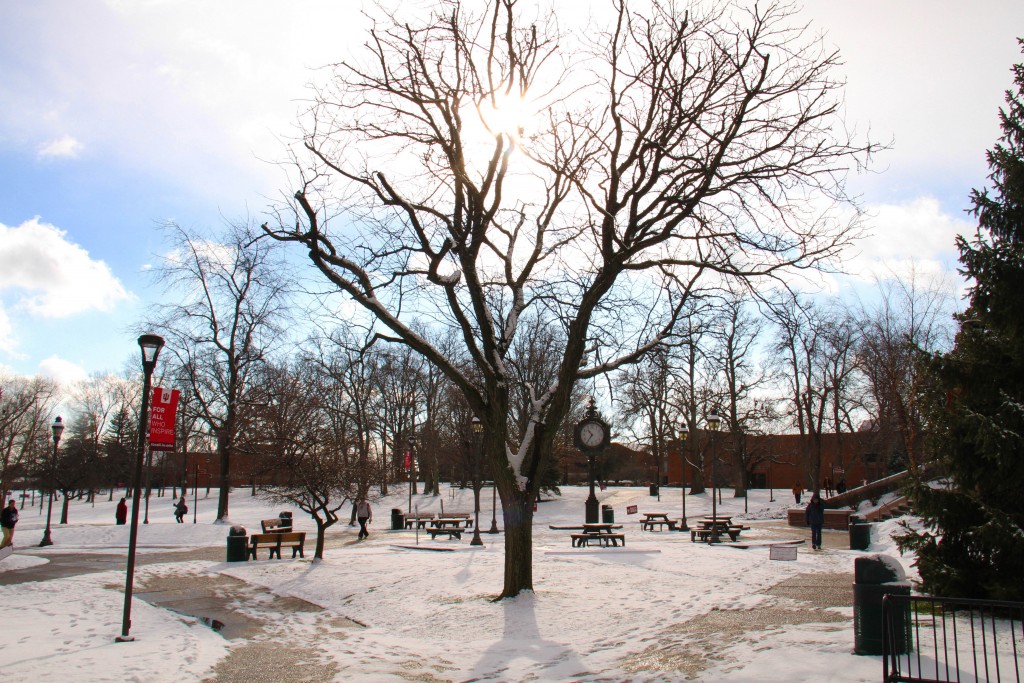
By Rachel Terlep
Winter isn’t coming. Winter is here.
After closing out 2015 with mild temperatures, the full force of winter weather hit Kentuckiana to start the 2016 spring semester. Sometimes the weather is bad enough to delay or cancel classes. Here’s a look at how IU Southeast arrives at that decision, as well as tips to get prepared and stay informed when the snow and ice start to accumulate:
How do IU Southeast administrators arrive at a decision when facing adverse weather conditions?
Ultimately, Chancellor Ray Wallace has the final say. The chancellor is advised by a core campus advisory group made up for the vice chancellor for administration and finance, executive vice chancellor for academic affairs, and staff for Emergency Management and Continuity, Campus Physical Plant, and IUPD. They all — especially IUPD, EMC, and Physical Plant — are watching the weather. They use a paid weather service and have contacts with the National Weather Service in Louisville. They also monitor local weather on radio and TV broadcasts. When there appear to be potential weather issues, IUPD initiates a conference call for this group to discuss the possible impact of the weather and options. The executive vice chancellor for academic affairs contacts the chancellor with their recommendation, and then the chancellor decides what to do.
If a decision is made to alter the campus status, such as to cancel class, IUPD will begin the process for issuing an IU-Notify alert to students and employees. Chief of Police Charles Edelen noted that “the IU-Notify alert is sent as soon as the decision has been made.”
Because of the commuter population at IU Southeast, it is important for students and employees to monitor weather in their own locations. The advisory group for the chancellor monitors weather and road conditions on campus and for Floyd County. Road and weather conditions in a neighboring county can be perilous even though no special measures are being taken at IU Southeast.
“Commuters need to monitor their local conditions and use their judgement when deciding to travel to work or class,” Edelen said. “If your conditions are not safe, we suggest you let your professor know by email why you are not able to attend.”
How to stay warm in inclement weather?
Hand warmers and double-layered socks go a long way. For a breakdown of how to prepare to face the bitter cold, check out IU Bloomington student Marina Allen’s blog post on how to dress for winter weather.
How to keep informed?
-Make sure IU-Notify contact info is up-to-date by reviewing it on one.iu.edu.
-Monitor weather for your particular county using social media (weather alerts from Twitter for IU Southeast @IUS_WxAlert), news organizations, or weather services. Each county in the state has an emergency management agency, which often provide weather alerts. Contact information for these agencies can be found here, http://www.in.gov/dhs/2797.htm.
-Check out the Indiana Department of Transportation’s trafficwise website, http://www.in.gov/indot/2420.htm, which provides real-time traffic conditions for major highways
-The Indiana Department of Homeland Security provides a county travel status map at http://www.in.gov/dhs/traveladvisory/. This information also is available on the Travel Advisory app, which can be downloaded from the Google Play Store and iPhone App Store.
-Indiana road conditions can be obtained by calling 800-261-ROAD(7623)
EMC staff advise students and employees to go through their emergency kits for their homes and vehicles to make sure they’re prepared for Indiana’s tricky weather. Weather conditions change rapidly in Indiana. Keep an emergency kit in your car and one at home for your family and pets.
The Protect IU website provides information about winter weather, https://protect.iu.edu/emergency-planning/personal-preparedness/weather-safety/winter-weather.html; severe weather and flooding, https://protect.iu.edu/emergency-planning/personal-preparedness/weather-safety/rain-flooding.html; and emergency kits, https://protect.iu.edu/emergency-planning/personal-preparedness/weather-safety/emergency-kits.html.
Falling is a concern on IU campuses, too. EMC and Environmental Health and Safety staff encourage people to do the “penguin shuffle,” taking small steps, and to keep hands free (not in pockets or carrying stuff). They should remember that curbs and steps are the most dangerous surfaces, so handrails should be used when possible.


